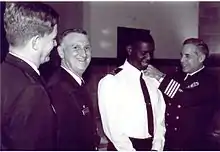Muslims in the United States military
Service by Muslims in the United States military dates back to the American Revolutionary War where records indicate that at least a few Muslims fought on the rebel side.[1]
Muslims have fought in all major US wars including the War of 1812,[2] the American Civil War, World War I, World War II, and the Vietnam War.[1] More recently they have served in Gulf War, Iraq War, and the War in Afghanistan.
On December 14, 1993, the Army Chief of Chaplains requested that an insignia be created to represent Muslim chaplains, and the design (a crescent) was completed January 8, 1994.[3]
In 2011 there were approximately 3,500 American Muslims serving in the United States military.[4]

Pre 9/11
_at_the_Zamboanga_Medical_Center.jpg.webp)
Muslims have fought and died in World War II and the Vietnam War. Some Muslim Americans served in World War II in North Africa, Europe, and Asia.[5] At least 12 Muslims are known to have died in the Vietnam War as well.[5]
Revolutionary War
Peter Salem was a notable African American who participated in the Revolutionary War. He played a particularly important role in the crucial Battle of Bunker Hill, in which he fatally shot British Marine Major John Pitcairn. Although there is no direct documentation of Salem's religious views, some scholars believe that he may have been Muslim.[6]
War of 1812
An African slave by the name of Bilali Muhammad defended Georgia's Sapelo Island from British attack during the War of 1812. He group consisted of 80 slaves who were mostly Muslim and armed with muskets.[7]
Civil War
Two hundred and ninety-one Muslims are known to have fought during the Civil War.[1] Some sources claim that highest ranking Muslim officer during the War was Captain Moses Osman.[1] However, Moses Osman was confirmed in the Zion German Lutheran Church in 1843 in Harrisburg, Pennsylvania, the son of Robert and Catherine Osman. [8][9] The surname Osman also has an old English origin, dating back to the 7th century.[10]
The actual most highly ranked Muslim in the War may actually be Nicholas Said. He came to the United States in 1860 and he found a teaching job in Detroit. In 1863, Said enlisted in the 55th Massachusetts Colored Regiment in the United States Army and rose to the rank of sergeant. He was later granted a transfer to a military hospital, where he gained some knowledge of medicine. His Army records state that he died in Brownsville, Tennessee, in 1882. Another Muslim soldier from the Civil War was Max Hassan, an African who worked for the military as a porter.[11]
After WWII
Abdullah Igram, a Muslim-American WWII veteran, campaigned for Islam to be an option in servicemembers' religious identification. His organization provided additional tags which soldiers were allowed to wear in 1953, and by then dog tags included codes for 'other' and 'prefer not to say'. By the Vietnam War, personnel could use a wide list of spelled out religion names. [12]
Post 9/11
Those people who resembled Muslims experienced an increase in verbal and physical attacks in the days following 9/11, despite efforts made by the White House.[5] South Asians and Arabs were targeted under discriminatory acts and hate crimes even though they may or may not have followed the Islamic belief. After 9/11, 6,024 served in the military in the Iraq and Afghanistan wars, with at least 14 being killed overseas. As of December 2015, only 5,896 of the 1.3 million active members of the US military self-identify as Muslim,[13] or roughly 0.45%. Rather than extremism, Islam itself is seen as the source of terrorist attacks after 15 years of war in the Arab states.[14] Practicing Muslims experience lack of culture representation, in which they have to shave their beards and routinely eat meals made with pork, a food source banned by Islamic customs.[14] Despite these setbacks, Muslim soldiers generally experience encouragement and camaraderie from their peers in which several have expressed openly their level of comfort while serving the military.[14] Muslim American involvement in the US military has come under increased attention after events such as the September 11 attacks terrorist attacks, 2009 Fort Hood shooting, and Khizr Khan 2016 Democratic National Convention speech. A 2013 YouGov poll found that 51 percent of American citizens considers Muslims just as patriotic as other Americans while 44 percent considered them to be less patriotic.[15]
Notable Muslims in the Military
Humayun Khan
Humayun Khan was a Pakistani-American born in the United Arab Emirates on September 9, 1976, to Pakistani parents. After graduating from the University of Virginia in 2000, he joined the U.S. Army's 201st Forward Support Battalion, 1st Infantry Division. Throughout his four years of service, he rose in ranks to become an officer in the U.S. army before being killed by a car bomb June 8, 2004, saving the lives of his fellow soldiers.[16] Republican presidential candidate Donald Trump’s temporary immigration ban based on a list of terror linked countries (created under the Obama administration) brought Khan's parents, Khizr and Ghazala Khan, into the public spotlight as they addressed Trump at the Democratic National Convention in 2016. Speaking out to defend their son, and others who died in the American military, created an "unexpected and potentially pivotal flash point in the general election" [11]
Colonel Douglas Burpee
Colonel Douglas Burpee is a retired U.S. Marine, having flown helicopters for 27 years. Burpee was born Episcopalian but converted to Islam when he was 19 in the late 1970s while attending the University of Southern California.[17] He was accepted into the Officers Candidates' School in Quantico, VA, after graduation. At the end of his service, Burpee was the highest ranking Muslim in the U.S. Marine Corps.[17]
 Muslim Chaplain insignia, Army
Muslim Chaplain insignia, Army Muslim Chaplain insignia, Navy
Muslim Chaplain insignia, Navy Muslim Chaplain insignia, Air Force
Muslim Chaplain insignia, Air Force
See also
References
- Curtis, Edward E. (2010). Encyclopedia of Muslim-American History. ISBN 9781438130408. Retrieved 22 August 2015.
- Robin Wright (2016-08-15). "Humayun Khan Isn't the Only Muslim American Hero". The New Yorker.
- Emerson, William K. (1996), Encyclopedia of United States Army Insignia and Uniforms, University of Oklahoma Press, ISBN 9780806126227, retrieved 22 August 2015
- The Muslim US Military Experience, Daniel Pipes, retrieved 22 August 2015
- University, Craig Considine Sociologist at Rice (2015-04-10). "Saluting Muslim American Patriots | Huffington Post". The Huffington Post. Retrieved 2016-10-07.
- Exploring Peter Salem's Roots. Worcester Telegram. Retrieved May 30, 2016.
- Richard Brent Turner (2003). Islam in the African-American Experience. Indiana University Press. p. 33.
- Historical Society of Pennsylvania; Philadelphia, Pennsylvania; Historic Pennsylvania Church and Town Records; Reel: 691
- https://www.library.illinois.edu/ihx/archon/?p=collections/controlcard&id=169 Osman, William. Letters, Letterbook, and Diary, 1826-1946, 1993-1994, 2003, Illinois History and Lincoln Collections
- "Surname Database: Osman Last Name Origin". The Internet Surname Database. Retrieved 29 May 2020.
- Haberman, Alexander Burns, Maggie; Parker, Ashley (2016-07-31). "Donald Trump's Confrontation With Muslim Soldier's Parents Emerges as Unexpected Flash Point". The New York Times. ISSN 0362-4331. Retrieved 2016-10-04.
- Rothman, Lily (2016-08-03). "The Khan Family and American History's Hidden Muslim Soldiers". TIME.
- "How Many Muslims Are Serving in US Military?". ABC News. 2015-12-09. Retrieved 2016-10-04.
- Philipps, Dave (2016-08-02). "Muslims in the Military: The Few, the Proud, the Welcome". The New York Times. ISSN 0362-4331. Retrieved 2016-10-07.
- "YouGov | 44% Question Muslim-American Patriotism". YouGov: What the world thinks. Retrieved 2016-10-07.
- "What you need to know about Humayun Khan". Retrieved 2016-10-04.
- Watanabe, Teresa; Helfand, Duke (2009-11-12). "Service members bridge gap between mosque and military". Los Angeles Times. ISSN 0458-3035. Retrieved 2016-11-09.